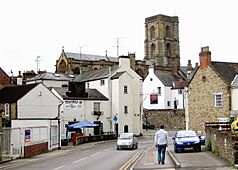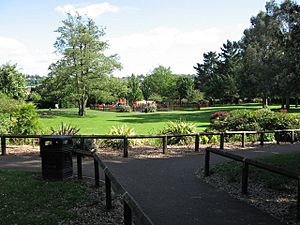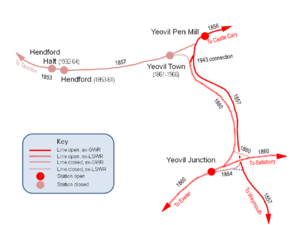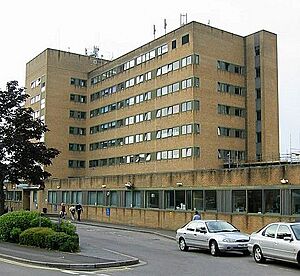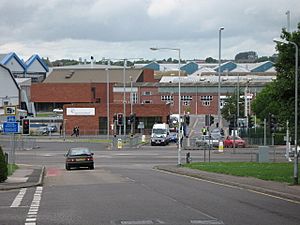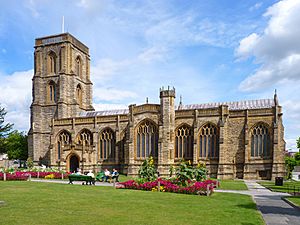Yeovil facts for kids
Quick facts for kids Yeovil |
|
|---|---|
|
From the top to bottom-right, View of Church of St John The Baptist, High Street, Abbey Barn, Yeovil Hospital, Woborn's Almshouse
Yeovil County Court |
|
| Population | 49,698 (2021) |
| OS grid reference | ST552164 |
| Unitary authority |
|
| Ceremonial county | |
| Region | |
| Country | England |
| Sovereign state | United Kingdom |
| Post town | YEOVIL |
| Postcode district | BA20, BA21, BA22 |
| Dialling code | 01935 |
| Police | Avon and Somerset |
| Fire | Devon and Somerset |
| Ambulance | South Western |
| EU Parliament | South West England |
| UK Parliament |
|
Yeovil (/ˈjoʊvɪl/) is a town and civil parish in Somerset, England. In 2021, about 49,698 people lived there. Yeovil is near the border of Somerset and Dorset. It is about 126 miles (203 km) west of London and 41.8 miles (67.3 km) south of Bristol.
For a long time, Yeovil has been important for making aircraft and for defence. These industries grew a lot in the 20th century. Because of this, the town was bombed during World War II. Today, these industries are still major employers in Yeovil. The town has many green spaces, like Yeovil Country Park, which includes Ninesprings. These parks offer places for learning, culture, and sports. Yeovil is also home to the Church of St John the Baptist, which was built in the 1300s. The town is connected by the A30 and A37 roads and has two train stations.
Contents
- Exploring Yeovil's Location and Landscape
- A Look Back at Yeovil's History
- How Yeovil is Governed
- Yeovil's Population and People
- Yeovil's Economy and Businesses
- Famous Places and Buildings in Yeovil
- Getting Around Yeovil: Transport Options
- Learning and Education in Yeovil
- Local Media and News
- Places of Worship in Yeovil
- Sports and Recreation in Yeovil
- Famous People from Yeovil
- See also
Exploring Yeovil's Location and Landscape
Yeovil is located in the southern part of Somerset, very close to the border with Dorset. It is about 130 miles (209 km) from London and 40 miles (64 km) south of Bristol. The town sits in the middle of the Yeovil Scarplands, which is a natural area of England.
Yeovil has many different areas, including Summerlands, Hollands, and Preston Plucknett. There are also villages nearby, such as East Coker, West Coker, and Montacute, which is famous for Montacute House. The village of Brympton is now almost part of Yeovil and has a very old manor house called Brympton d'Evercy.
Ninesprings Country Park is a large park in the south-east of Yeovil. It is connected to other green areas like Riverside Walk and Wyndham Hill by a cycle path. Together, these form the 40-hectare (99-acre) Yeovil Country Park.
Yeovil's Weather and Climate
Yeovil, like the rest of South West England, has a mild and often wet climate. The average yearly temperature is about 10 °C (50.0 °F). Temperatures change throughout the day and year, but the sea helps keep them from getting too extreme. January is usually the coldest month, with temperatures between 1 °C (33.8 °F) and 2 °C (35.6 °F). July and August are the warmest, with daily highs around 22 °C (71.60 °F).
The South West often gets good weather when high pressure from the Azores moves over the UK, especially in summer. However, clouds can form inland, reducing sunshine. Yeovil gets about 1,700 hours of sunshine each year. Rain often comes from storms over the Atlantic Ocean. These storms are stronger in autumn and winter. The average rainfall is about 725 millimetres (28.5 in). Winds are strongest from November to March and lightest from June to August. The wind usually blows from the south-west. Yeovilton
A Look Back at Yeovil's History
People have lived in the Yeovil area for a very long time. Archaeologists have found ancient burial and settlement sites, especially in Hendford. A golden torc (a twisted necklace) from the Bronze Age was found there.
Yeovil was on a main Roman road that connected Dorchester to the Fosse Way at Ilchester. The modern A37 road follows parts of this old Roman route. There is also evidence of a small Roman town where the Westland site is today. Several Roman villas (large country estates) have been found nearby in places like East Coker and Lufton.
Yeovil in Medieval Times
The town of Yeovil was first mentioned in a Saxon document in 880, called Gifle. This name comes from an old British river name, gifl, meaning "forked river," which was an earlier name for the River Yeo.
King Alfred the Great left the estate of Yeovil to his youngest son, Aethelweard. In the Domesday Book, a survey from 1086, Yeovil was recorded as Givele and was a busy market town. In 1205, King John gave Yeovil a special charter, which helped it grow. By the 1300s, the town could elect its own leader, called a portreeve.
The Black Death, a terrible disease, hit Yeovil hard, killing about half of its people. The town also suffered from major fires. In 1499, a large fire destroyed many wooden buildings with thatched roofs. More fires happened in 1620 and 1643.
Who Owned Yeovil?
After the dissolution of the monasteries, the Horsey family owned the manor of Yeovil from 1538 to 1610. Then, the Phelips family took over until 1846, when it passed to the Harbins of Newton Surmaville. During the English Civil War, a small battle called the Battle of Babylon Hill took place near Yeovil. Here, the Earl of Bedford's Roundheads (supporters of Parliament) pushed back Sir Ralph Hopton's Cavaliers (supporters of the King).
How Yeovil Grew and Changed
In the 1800s, Yeovil was famous for making gloves, and its population grew quickly. In the mid-1800s, train lines connected Yeovil to the rest of Britain. There was a lot of competition between the Great Western Railway (GWR) and the London and South Western Railway (LSWR). The GWR opened a line to Yeovil in 1853.
Yeovil's first train line opened on October 1, 1853, connecting it to Taunton. In 1856, the GWR opened Yeovil Pen Mill railway station as part of its route from London. The LSWR route from London reached Yeovil in 1860. A new station, Yeovil Junction, was built south of the town. Later, in 1861, passenger trains moved to a more central station, Yeovil Town railway station.
In 1854, Yeovil became a borough and had its first mayor. By the early 1900s, Yeovil had about 11,000 people. The town was very important for the defence industry, which made it a target for German air raids during World War II. The worst bombings happened between 1940 and 1942. During this time, 107 bombs fell on the town, 49 people died, and many houses were destroyed or damaged.
Because of the growth of road transport and changes to the railway system, some train stations in Yeovil closed in 1964. Today, Yeovil is known as a "post-industrial" town because its old leather industry has declined.
How Yeovil is Governed
Yeovil became an official Municipal Borough in 1854. Later, in 1974, it became a local government district called Yeovil, which then merged with other areas to form South Somerset. Some parts of Yeovil are in the civil parishes of Yeovil Without and Brympton.
Yeovil still has a town council. This council manages local parks, leisure facilities, and play areas. In 2005, Yeovil Town Council was recognized for its high quality. The town council is based at the Town House. All other local services are provided by Somerset Council, which is a larger council for the whole area.
Yeovil is also a county constituency for the House of Commons in the UK Parliament. This means it elects one Member of Parliament (MP). The Yeovil constituency includes the towns of Yeovil, Chard, Crewker, and Ilminster. The current MP for Yeovil is Adam Dance.
Yeovil's Population and People
In 2011, the population of the built-up area of Yeovil was 45,784. This number includes parts of the nearby parishes of Yeovil Without and Brympton. This population made up 28% of the total population of the South Somerset district.
| Population since 1801 – Source: A Vision of Britain through Time | |||||||||||||
| Year | 1801 | 1851 | 1901 | 1911 | 1921 | 1931 | 1941 | 1951 | 1961 | 1971 | 1981 | 1991 | 2001 |
|---|---|---|---|---|---|---|---|---|---|---|---|---|---|
| Population: South Somerset | 70,769 | 93,075 | 85,080 | 84,280 | 85,001 | 85,729 | 92,313 | 99,407 | 106,462 | 114,020 | 129,310 | 143,395 | 150,974 |
Yeovil's Economy and Businesses
Yeovil is a key center for making helicopters. Leonardo (formerly AgustaWestland) builds helicopters in the town. Another important company, Honeywell Aerospace, which used to be called Normalair Garratt, makes aircraft oxygen systems there.
The aircraft and defence industries have been very important to Yeovil for a long time. Leonardo, which bought Westland in 2000, is still the biggest employer in the town. BAE Systems, a large British defence company, also has a site in Yeovil. They create advanced software, mainly for the armed forces.
Yeovil Aerodrome (sometimes called Yeovil/Westland "Judwin") is about 1 nautical mile (1.9 km) west of the town center.
Screwfix, a company that sells tools and hardware, started in Yeovil in 1979. It is now part of Kingfisher plc. The company's main warehouse moved to Stoke-on-Trent because it couldn't get permission to expand in Yeovil.
The Quedam Shopping Centre in Yeovil has about 45 shops. These include well-known high-street stores and smaller independent shops. It also has a large car park.
In 2015, Pittards, a leather manufacturer, bought back its tannery in Sherborne Road, Yeovil. However, in September 2023, the company went into administration.
Famous Places and Buildings in Yeovil
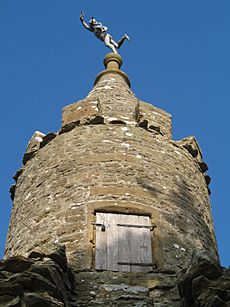
One interesting symbol of Yeovil is "Jack the Treacle Eater." This is a folly (a building built just for decoration) in the village of Barwick, just south of Yeovil. It has a small archway with a turret and a statue on top.
The Abbey Farm House was built around 1420. The Abbey Barn was also built around the same time. Both are made from local hamstone.
Hendford Manor, in the town center, was built around 1720 and is now used as offices. It is a Grade II* listed building, meaning it is historically important. Newton Surmaville is a house and park built between 1608 and 1612 for Robert Harbin, a merchant from Yeovil. It is a Grade I listed building.
Yeovil has two main entertainment venues: the Octagon Theatre and the Swan. The Swan is now a cinema with ten screens and an 18-lane bowling alley.
Somerset NHS Foundation Trust, which includes Yeovil Hospital, provides health services for the local area.
The Yeovil Railway Centre is a small museum that opened in 1993. It was created when British Rail decided to remove the train turntable from Yeovil Junction. Visitors can see demonstration trains on a short section of track.
Getting Around Yeovil: Transport Options
Buses and Coaches
Yeovil has many bus services run by different companies like First West of England and South West Coaches. These buses connect the town center to the train stations, and to other towns like Taunton, Blandford Forum, and Wells.
Coach services, run by companies like National Express, connect Yeovil to Taunton and London. There is also a special service called North Dorset Community Accessible Transport (NORDCAT) that helps people get to places without regular public transport.
Train Travel
Yeovil has two train stations, which are on different lines:
- Yeovil Pen Mill is on the Heart of Wessex Line, which goes from Bristol to Weymouth. Great Western Railway operates services from this station. It is just under 1 mile (1.6 km) east of the town center.
- Yeovil Junction is on the West of England Main Line, which connects London Waterloo to Exeter. South Western Railway serves this station. It is just over 1.75 miles (2.82 km) south of the town center.
Roads and Driving
The town is located on the A30. This road used to be the main route between London and the South West. Now, the A303 is the main route, which is to the north of Yeovil. Junction 25 of the M5 motorway is about 20 miles (32 km) west of Yeovil, near Taunton. This motorway provides access to Bristol and the Midlands. Yeovil is also on the A37, which is a north-south road connecting Bristol and Weymouth.
Learning and Education in Yeovil
For students who want to continue their education after school, Yeovil College offers many courses. Some land-based studies are also available at a Yeovil center of Bridgwater College.
Yeovil also has a higher education center called University Centre Yeovil. This center works with Bournemouth University and the University of the West of England to offer degree courses.
There are four main secondary schools in Yeovil: Westfield Academy, Preston School, and Bucklers Mead Academy. Famous people like actress Sarah Parish and cricketer Ian Botham attended schools in Yeovil.
Local Media and News
For local television news, Yeovil is covered by BBC West and ITV West Country. Radio stations include BBC Radio Somerset, Heart West, Greatest Hits Radio South West, and Radio Ninesprings. Local newspapers are the Western Gazette, Somerset Guardian and Standard, and SomersetLive.
Places of Worship in Yeovil
The Anglican Church of St John the Baptist was built in the late 1300s. Its tower is 92 feet (28 m) high and has four levels. The church is a Grade I listed building, meaning it is very important historically.
Yeovil also has a Roman Catholic Holy Ghost Church and three Methodist churches. There is a Baptist church, the Salvation Army, and the Elim Pentecostal Church. Other churches include Yeovil Community Church and Yeovil Family Church. A mosque on Sherborne Road opened in May 2017.
Sports and Recreation in Yeovil
Yeovil's main football team is Yeovil Town F.C.. They play in green and white at Huish Park and are known as the "Glovers," a nod to the town's history of glove-making. The club was founded in 1895. In 2003, they won promotion to the English Football League for the first time. They have also had famous wins against bigger teams in the FA Cup. In women's football, Yeovil Town L.F.C. was founded in 1990 and reached England's top league in 2016. Other local football teams include Westland Sports F.C. and Pen Mill Athletic.
The Yeovil Olympiads Athletics Club, started in 1969, has helped many athletes become international stars. These include Olympic hurdlers Max Robertson and Gary Jennings.
Yeovil is home to Ivel Barbarians Rugby Club, which was formed in 1995.
The Goldenstones Pool and Leisure Centre has a 25 metres (82 ft) swimming pool, a teaching pool, a gym, and a sauna. Preston Sports Centre has also been updated with a new gym and dance studio.
There were plans to build a large sports zone on Yeovil Recreation Ground, but local residents fought to protect this popular green space. The plans were rejected in 2009.
The recreation area known as Mudford Rec was a place where England cricket star Ian Botham played as a child when he lived in Yeovil.
Famous People from Yeovil
Many notable people have connections to Yeovil:
- Stukeley Westcott (17th century) was an early American settler. He helped found Providence, Rhode Island, which was a place known for religious freedom.
- Alison Adburgham (1912–1997), a social historian and fashion journalist, was born in Yeovil.
- Film historian William K. Everson (born 1929) and Catholic writer Michael T. Davies (born 1936) were also born here.
- Sports stars include Luton Town defender Martin Cranie, Olympic pentathlete Sam Weale, and his twin brother Chris Weale, a former professional goalkeeper.
- Heather Stanning, who won a gold medal in rowing at the 2012 Olympic Games, was born in Yeovil.
- Marlie Packer, who won the Rugby World Cup with England Women in 2014, is from Yeovil.
- In the arts, there's Jim Cregan, a guitarist for Steve Harley & Cockney Rebel, musician John Parish, and his sister, actress Sarah Parish. Artist Flora Twort was born in Yeovil in 1893.
See also
 In Spanish: Yeovil para niños
In Spanish: Yeovil para niños


